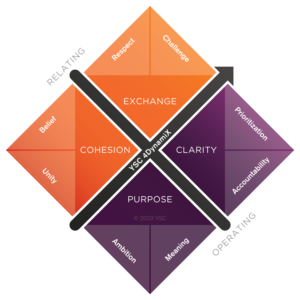The COVID-19 pandemic is disrupting teamwork like nothing before. For the first time in history, most teams are moving to virtual working with minimal preparation. Teams will have to adapt to this new way of working at the same time as coming to terms with unprecedented challenges across all elements of organizational life.
This means that team dynamics are now more important than ever before. No one knows how long the present situation will last, but one thing is certain: the ability to work together is going to be essential if we are to adapt and thrive in a ‘new normal’. It will require agility to work efficiently and supportively as a team, even whilst apart. Research suggests that virtual working and geographical dispersion has a negative effect on team performance – except in teams with strong dynamics, where there is no drop-off. We’ve synthesized huge amounts of external and internal information to find out what, in practical terms, teams can do to improve both their internal dynamics and those between teams.
The YSC 4DynamiX Model of Team Effectiveness

The YSC 4DynamiX Model of Team Effectiveness outlines the core elements of great teamwork: the strength of our relationships (Cohesion & Exchange), and how we operate together to achieve our goals (Purpose & Clarity).
So what quick advice can our research give us about how teams can stay agile and responsive whilst apart and under strain?
Purpose
Stay focused by stating your team’s purpose during this period.
Purpose is the ‘why’ statement that guides us when setting goals and priorities. In times of flux it is natural to feel uncertain over where to focus. Having a common reason to work when you are remote is vital: a shared group purpose is motivating and bonding. Without it, anxiety and lack of direction derail teams. Stay flexible and be prepared to change focus when the situation develops.
![]()
Top tip! If the longer-term purpose of your team doesn’t fit the current situation, briefly decide on a small purpose statement each week with your team. Even if it’s as simple as ‘keeping our customers perfectly informed’, purposeful goals will focus the team on what matters and reduce anxiety.
Cohesion
Grow team unity by continuing informal dialogue.
The need for cohesion, a sense of togetherness, and shared belief is amplified during a crisis. Yet when under stress even the best of us can become transactional, sacrificing bonding for efficiency. This becomes a ‘false trade-off’. The reality is that investing a small amount of time to connect personally builds a sense of support which offsets physical remoteness. Small talk generates a feeling of belonging, and solidarity reduces negative emotions which erode the ability to focus.
![]()
Top tip! Schedule quick informal ‘coffee calls’ with colleagues during the day – which also creates a screen break to make a drink. Use digital platforms to stay in touch. See how people are. Don’t feel guilty about personal calls, because these small but meaningful conversations motivate people to keep focus on the greater good.
Exchange
Ensure open and constructive dialogue by verbalizing body language.
Exchange means having robust and challenging conversations, whilst creating a space that allows everyone to speak up. Effective teams combine both diversity of thinking and decisiveness. These conditions are essential for teams under stress, but fostering the necessary atmosphere virtually is a challenge. Body language, and other subtle social cues picked up in a room with people are no longer at your disposal, so you need to be more explicit with your words.
![]()
Top tip! When using video conference technology, be sure to make the positive intent of your messages clear. For example, stating, ‘I’m feeling a bit stressed today, but I’m glad we’re making progress’ helps people understand your sentiment. Be succinct with your points and follow up with a question to encourage the exchange of ideas.
Clarity
Stay operationally efficient by keeping everyone on the same page
Clarity is about transparent roles, responsibilities and priorities. Alignment is going to be challenging given the current organizational flux and mass remote working. Virtual teams require frequent interactions to prioritize what matters in a changing context, and need to communicate agile adjustments. Effective teams have ‘shared mental models’ of what is important, and so keeping everyone on the same page is essential when people are dispersed and priorities are shifting.
![]()
Top tip! Be as transparent as possible without overloading people. Increase the frequency of communications, but decrease the length. Link shifting priorities both to the changing context and to your team’s purpose, which maintains focus on what matters.